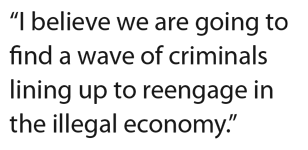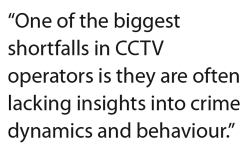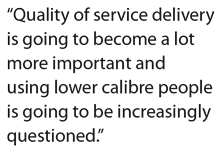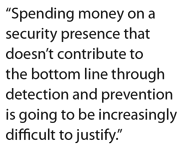
The most used words in history over any short period must have been lockdown, Coronavirus and COVID-19. Across every country in the world, the words have dominated all forms of media and conversations in a way that dwarf words such as ‘world cup’.
Lockdown does come in a range of different terms depending on which country is involved, ‘Shelter in place’ from the US is possibly the most innocuous and pleasant sounding version, ‘stay at home’ is used widely but particularly in the UK, the term ‘Circuit Breaker’ seems to be popular in Singapore, while Movement Control Order (MCO) is the term used in Malaysia. Common to all of these is the philosophy of restriction and control of movement of people.

This may vary from places like Wuhan where an almost total lockdown occurred besides for those people in a small range of essential services, to the US where protestors marched (or drove) in the streets despite ‘shelter in place’ orders. Generally, however, the public has been incredibly tolerant of lockdown regulations and have maintained a high level of adherence to the ‘stay at home’ requests, despite complaints and severe adversities. Like everybody else, this control has also restricted movement of criminals in ways that the efforts of roadblocks, stop and search, and ‘on the beat policing’ could never come close to.
The challenges of doing crime
The restriction of criminal movement has generally led to a reduction of crime internationally. Criminals need mobility and access in order to commit crimes and three men in a car driving at 3 am in the morning or even 10 am in the morning in a lockdown situation stands out like a sore thumb. For other criminals, the need to blend in with people assists with their disguises and tactics and where there are no other people as targets, it restrains them significantly.

Even social distancing plays a part, as getting close for mugging somebody in the street calls attention as much for violations of lockdown requirements as it does for criminal action. Another factor is that in the case of things like house burglary, the environment in which criminals operate is fully populated by people staying at home and who bring some kind of mutual protection when there are continually people next door. It makes stealing a lot more difficult to do and there is much more likelihood of being caught while making the escape in streets where the criminal is about the only one moving. Other crime targets have been shut down completely, removing traditional opportunities.
This doesn’t mean that criminal opportunities have been eliminated altogether. Bans on alcohol and tobacco, like in South Africa, as well as other goods create black market opportunities that out of work criminals can move into. Some riot or protest situations may be engineered or stimulated by criminal elements to create chances of access to immobilised delivery trucks or belongings of drivers passing by. Similarly, attacks on stores providing food or liquor can result in extensive looting where sufficient protection is not available. Police fulfilling lockdown duties are also thinly stretched and may also not be in positions to address crime conditions.
Nevertheless, crime during lockdown appears to have been significantly reduced, but this may well be the calm before the storm.
Desperate measures
Poverty, a lack of a social support infrastructure like effective food distribution, extended time periods of being unable to pay for housing or accommodation or contracts are going to create a whole group of desperate people who may steal because they feel they have no other option. In its most simple context, people may just be trying to find something to allow them and their family to eat.

Even previously middle class or well-off people who have lost incomes and livelihoods could respond by engaging in criminal actions. Those who may have been flirting on the borders of crime may find that desperation pushes them into committing illegal actions despite some hesitation previously. Any crime wave resulting from these kinds of people is largely likely to be opportunistic in nature with increases in petty theft, as well as traditional crimes such as shoplifting and housebreaking.
Theft from public areas, especially in offices, hotel and retail areas is likely to increase with things like cellphone and bag snatching increasing. Shopping centres are likely to be frequented more for chances to steal and as transport starts increasing, trains and airports are likely to feel the heat. Pilfering in factories and in distribution centres and incidents like ATM crime is likely to increase as well. Employees working in companies who are feeling pressure from supporting families or dependents may also be more prone to going over the line and committing petty theft despite a reluctance to do so and white-collar crime is also likely to increase.
Criminals who were operating previously, have been under lockdown and in constrained conditions for some time, especially for those who were operating in areas where opportunities have literarily dried up. Professional criminals don’t get unemployment insurance, and would have been particularly badly hit, unless they found other opportunities in the black market sectors or by focusing on particularly vulnerable targets.
Crime resurgence
So I believe we are going to find a wave of criminals lining up to re-engage in the illegal economy, wanting to catch up for lost time and getting resources for themselves and their families. Convicts released into society under government parole are coming into communities already under stress, with unemployment at record levels. It is going to be very difficult for those released to resist falling into bad habits, no matter their good intentions. This range of existing criminals makes for many desperate people who are experienced in carrying out crimes and are likely to return to these ways and reinitiating the old crime patterns.

Even more concerning is that criminals who are desperate are more likely to be prepared to face danger in committing crimes than previously, with the potential for violence increasing.
Syndicates, by nature, are groups of criminals who work together to commit crimes, usually in a specialised type of crime area. Lockdown has the potential to separate them from each other, unless from the same community, and from their targets. These syndicates would normally be operating in the broader society where they have their targets, or within organisations from which they are stealing and sometimes a combination of both.
Informal zama zama groups stealing gold-bearing material and breaking into gold plants, as well as syndicates working within the plant itself as employees are examples of this in the gold sector. Over the strict lockdown period, possibilities would have been restricted unless they were stealing within an essential services sector. So, we have the potential for syndicates starting up again in their respective areas, as well as situations where the lockdown has created spaces which were previously occupied. These now become contested as organised gangs start re-establishing their turf and others may try and occupy that space. Again, for syndicates to maintain membership they have to provide for their members and they are going to reinitiate activities as soon as possible.
A post-lockdown security challenge
Security is going to face massive and possibly unprecedented challenges in dealing with potential crime, yet these issues can only really be addressed by sufficient community support structures and assistance at a range of levels, as well as government interventions focused on opportunities for employment and aid for the desperate. Even in a best-case government support scenario, security is likely to have a critical role in managing the potential impact of crime. CCTV will be an essential component in this as part of a deterrence, detection and response function.
CCTV, properly done, allows the early detection of crime conditions or suspects through recognition of pre-conditions using incident and crime behaviour analysis. This includes identifying likely targets and arranging protection and identifying suspects through positioning and body language profiling. Crimes such as cellphone and bag snatching, pickpocketing, smash and grab can be stopped if the right resources are in place.
Intelligence led surveillance, whether it is recognition of known suspects through suitable personnel, number plate recognition, analysis of movements, tracking of crime trends and hotspots, or other techniques can assist in early detection. This allows security on the ground to engage in active deterrence of those who may be thinking of crime, or diverting those people likely to be looking for opportunities to commit offences.
Stopping crime in public places, ATMs, shopping centres, preventing shoplifting in stores and places like casinos, restaurants, entertainment and transit centres such as airports is important, as all are likely to be targeted by people looking for opportunities. Many of these people may not be experienced criminals, but compelled by desperate living conditions. We can expect that the need for perimeter protection is going to increase, particularly in areas such as residential and business estates, mining areas and universities among others.
The importance of control room operators
CCTV operators are going to have to pay more attention to protecting high-risk targets in the sector where control room operators are working. CCTV viewing strategies need to be aligned to the potential crime needs – the most relevant cameras need to be viewed during the most relevant times. Critically, control room operators need to know what to look for and spot conditions that tell them incidents are happening. Yet I find that this is one of the biggest shortfalls in CCTV operators – they are often lacking insights into crime dynamics and behaviour.
Detection of syndicate behaviour is going to be even more important than before. This covers both external environments such as criminals targeting a shopping mall, as well as internally in organisations such as logistics, mining, factory production and other enterprises producing or handling things of value. Ideally, this should involve spotting syndicates as they are trying to re-establish themselves, as the longer the syndicate has to embed itself, the more difficult it is to get rid of. The challenge in dealing with syndicate theft is to spot both the crime behaviour, as well as the intergroup communication and contact behaviour.
Control room operations and response effectiveness is going to be important if CCTV is going to have the right effect. This starts in the control room with the actions and communication when an offence is committed, through to effective communication and instructions to response personnel and wrapping up the incident scene afterwards. The need for calm communication under pressure and the need to follow procedures during emergencies or apprehending suspects of incidents is going to be crucial. The use of training and simulations for these kinds of events to get a skills base in place is recommended.
Security operating in a post or even semi-post lockdown environment is going to be asked to provide more and a better level of protection, in a tougher environment, with less cost. Quality of service delivery is going to become a lot more important and using lower calibre people is going to be increasingly questioned.
Margins of companies are going to be squeezed in the best of conditions, and spending money on a security presence that doesn’t contribute to the bottom line through detection and prevention is going to be increasingly difficult to justify. Expenditure on new technology is going to have to be accompanied by measurable increases in detection and decreases in crime impact costs to companies. We can expect security managers and security service providers to come under increasing scrutiny to up their game.

Dr Craig Donald is a human factors specialist in security and CCTV. He is a director of Leaderware which provides instruments for the selection of CCTV operators, X-ray screeners and other security personnel in major operations around the world. He also runs CCTV Surveillance Skills and Body Language,
and Advanced Surveillance Body Language courses for CCTV operators, supervisors and managers internationally, and consults on CCTV management. He can be contacted on +27 11 787 7811 or [email protected]
| Tel: | +27 11 787 7811 |
| Email: | [email protected] |
| www: | www.leaderware.com |
| Articles: | More information and articles about Leaderware |

© Technews Publishing (Pty) Ltd. | All Rights Reserved.